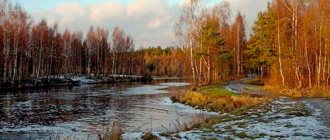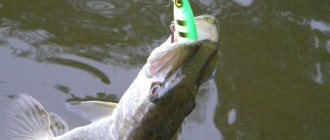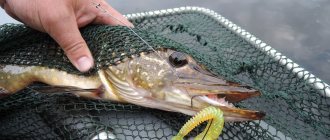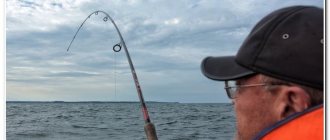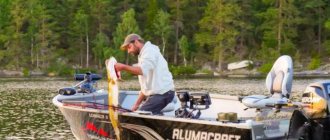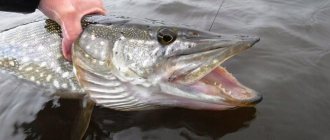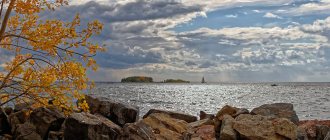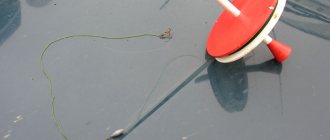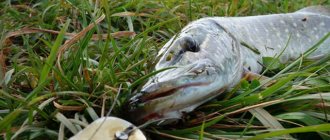Where to catch pike in May
In the spring, having spawned, the pike does not leave the spawning grounds for some time, hunting and restoring strength near them.
So on the river the most promising places are:
- Shallow oxbows and backwaters connected to the main channel by a never-drying ditch or canal.
- The bays are overgrown with last year's and fresh aquatic vegetation.
- Small rivers with a slow flow, shallow depth and an abundance of last year's grass.
- Floodplain lakes connecting to the river.
- Sandy beaches in backwaters, bordered by sharp drops into holes.
On the lake, during a warm and friendly spring, pike are just as very active as on the river. In reservoirs with standing water for pike fishing, you should choose the following places:
- Extensive and shallow watering.
- The mouths of streams and rivers flowing into the lake.
- Flooded trees and bushes lying at shallow depths.
- Flooded stumps and snags.
- The upper edges of the slopes.
When choosing a place in the spring, you should remember that at this time the pike prefers depths of no more than 1.5 meters, since it is there that the water warms up best, thereby attracting small fish on which the predator feeds.
Best lures
In May, the water has already warmed up in some places, so the arsenal of baits is expanding by adding surface ones and those with slight depth. The spinning rod must be powerful and reliable. Particular attention should be paid to the selection of the cord. In such fishing conditions, it is recommended to use braid with a diameter of 16 to 20 pounds.
Surface baits
Since peaceful fish, a potential target for predators, in shallow reservoirs try to stay in the upper layers of water, surface baits such as poppers and walkers, as well as baits that are their hybrids, can be used to catch pike. Thanks to the recess in the front part of the body, they create the “gurgle” characteristic of a popper, and a special centering ensures accurate and long-distance casting. Plus, there’s the zigzag animation that’s unique to walkers.
Silicone
At shallow depths when jig fishing, edible floating silicone shows good results, and here the edibility of the rubber is not so important as its buoyancy. During the pause, the bait does not lie on the bottom, its tail floats up, in this position the predator willingly attacks the artificial fish.
Lures with depth
If a pike comes to a large bait, but does not take it, it makes sense to put something smaller. Usually, after changing the bait, a successful bite occurs. Sometimes the pike misses, and this happens for the reason that it is guided by the sound of a noise wobbler.
In case of such a miss, there is no need to change the bait; you should cast again; as a rule, the May pike, having recovered from spawning, will definitely pay attention to the wobbler and this time will try not to miss.
They say that “iron” works better in the fall, however, catching pike in May with spoons can be almost as effective as in October, but it is still better to give preference to wobblers.
When to fish during the day
At the beginning of the month, when the mornings are often still quite cool, the pike begins to actively feed only closer to 9-10 o’clock, when the water in shallow waters warms up, thereby attracting small fish.
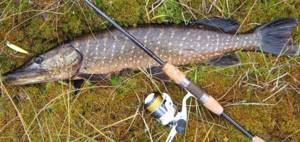
This feature is especially well observed during night frosts in May. This is interesting - The best weather for pike, as well as the normal atmospheric pressure for hunting for toothy ones.
Depending on the weather, but, as a rule, from the third ten days of May, pike begins to become more active early in the morning and before sunset. This is interesting: When to catch pike in the spring
Fishing for pike with live bait is one of the most common ways to catch May pike
It should immediately be noted that live bait is used to catch pike at all times of the year, and not just in the month of May; among other things, pike are caught with live bait using all known pike tackles and rigs. At the same time, catching toothy fish with live bait is the most ancient method of catching pike; it was used by fishermen of Ancient Greece, Ancient Rome, Ancient Egypt, and fishermen of the Sumerian state.
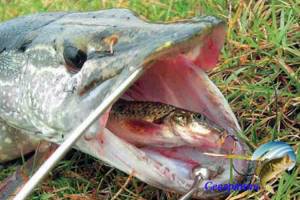
Experienced pike fishermen say that as live bait it is imperative to use those fish that are found in the fishing pond. At the same time, pikes most of all prefer live bait with active play, although they often attack chewed and bitten live bait, because they give off the smell of blood, which spreads very strongly throughout the reservoir.
Live bait, in most cases, is caught using conventional float rods. If you attach large live bait, then there is a chance to catch very large specimens of pike, although you may also catch other predatory fish of the reservoir, such as perch, pike perch, catfish and others.
Spinning for pike in May
To catch May pike, you should correctly assemble the spinning tackle, taking into account the characteristics of fishing, the size and type of bait used. The most suitable gear would be one with the following components (This is interesting: How to choose the right spinning rod).
Rod - for fishing, a 2.4 meter long spinning rod with a fast or ultra-fast action and a cast from 5 to 15-20 grams is used. When fishing with jig baits, the tip of the rod should be thin and sensitive; for wobblers and spinners, blanks with a hard and durable tip are used.
Reel - in pike fishing, the most widely used are inertia-free reels of size 2000-2500, with a front-mounted friction brake, having at least 4 bearings - in this case, the line roller must be equipped with a reliable ball bearing.
The body and rotor of the reel must be made of light and durable carbon fiber alloy. For ease of use of the reel when retrieving and fishing, it is better to choose models that have a comfortable and large knob - that part of the handle with which the angler rotates it. The gear ratio of the reel should be at least 5:1.
We choose and fish with the best spinning rod for:
- jig;
- twitching;
- ultralight.
Line or cord?!
- Cord - for catching pike in the spring, thin and strong braided cords with a cross-section of 0.06 to 0.1 mm are used. When choosing a cord by color, many anglers prefer brightly colored models - this allows them to track the direction of movement of the bait along the line of a brightly colored cord that stands out well on the surface of the water.
- When choosing a cord, preference should be given to original products - cheaper Chinese analogues quickly wear out, fade and lose their strength after one season.
- The leash is thin and flexible, no more than 20 cm long, with a clasp and swivel. These requirements are met by tungsten or thin steel leashes sold in fishing stores, as well as fairly strong and flexible leashes made from guitar string.
You need to tie fishing line/braid to the spool correctly - read here.
Features of fishing with spinning rod
This method of catching pike is quite productive with the right approach. Telescopic models work well. They are effective in areas with dense vegetation and are convenient for transportation and storage.
The optimal places for spinning are overgrown areas and places with fallen trees.
Not all spinning baits are good at this time of year. Only those that can attract fish through noise and color are considered effective.
Experienced fishermen often like to use the following types:
- noise wobblers;
- oscillating spoons;
- rotating spoons.
Topwater baits such as poppers and sliders are not recommended.
Technique for catching May pike
In order to catch a pike in May, it is necessary to take into account the degree of activity of the predator when performing all technical elements.
- The cast - vertical or lateral - must be as accurate as possible.
- Wiring - in May they use more aggressive wiring than in April. Twitching wiring should be without pauses with sharp frequent jerks; I animate jig baits using a standard step-by-step wiring with an average or reeling speed. For spinners, uniform wiring is used.
- Hooking - a sharp and biting wrist hooking with any suspicious blow should pierce the dense and durable tissues of the pike mouth with hooks
- Fishing - with proper hooking, medium and small pike are caught quickly, preventing it from getting tangled in the cord in the grass or snags. Large specimens are fished out carefully, alternately loading the rod blank and the reel - slow pulls are made with the blank, and the slack that forms in this case is removed with the reel.
Wobbler wiring and color
In the southern regions, where pike have spawned for a long time, you can experiment with retrieves: as an option, in search of an active predator in warm water, you can try a quick retrieve, this will allow you to check a decent area of the reservoir for the presence of pike in a short period of time. If the fish is active, it will definitely be tempted by a fast-moving fish.
In more northern areas, where the water is still cold and muddy, there is no need to rush. Immediately after spawning, pike are very weak, so it is recommended to use slow retrieval to catch them. Deep-sea wobblers work better for passive pike.
Suspenders and Compounds
To work in depth, it is better to choose wobblers marked SP, which means that the bait will either hang in the water column or slowly sink. Such wobblers are called suspenders; for catching pike in May, with leisurely twitching, they work excellently.
Pay attention to the so-called compounds. When moving, they imitate a wounded fish, which, from the pike’s point of view, can become easy prey, which attracts the predator.
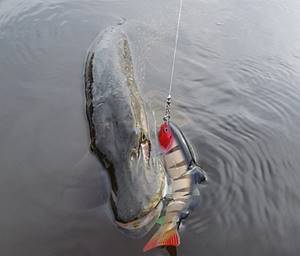
When catching a passive pike while moving large wobblers, pull the pauses and make the pulls long and smooth; for active pike, the pace accelerates, the pauses become shorter, and the pulls are more like jerks.
Advice
In muddy water after heavy May rains, bright colors will work better - orange or acid (mat chart).
In clear water, natural colors are used, which include silver, which is loved by many spinning anglers, as well as translucent wobblers of natural colors to resemble live fish.
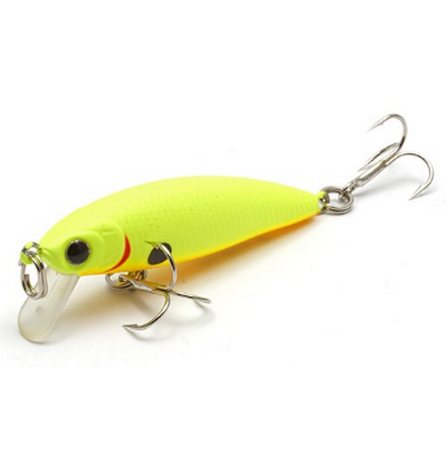
Thus, catching pike in May with a spinning rod depends on the timing of spawning in a particular region, that is, on the activity of the predator. In accordance with this, baits and wiring methods are selected.
Choosing a fishing spot
It is also worth noting a number of features of their placement in the summer, which place can become adhesive:
- Pits, edges and spits , which are the standard place to stay, become unacceptable for them on flood days; the fish looks for similar places closer to the shore.
- Backwaters . Especially with reverse flow. They attract a lot of different fish, and they attract pike.
- Thickets of grass . At this time, there is still little of it in the reservoir and a small individual can hide in it.
- Large fish stand more on the border between clear and muddy water , which helps them effectively hide behind the veil of turbidity and make more successful attacks on other fish.
